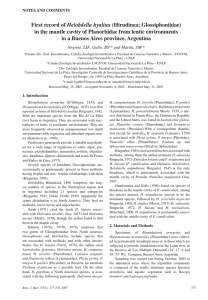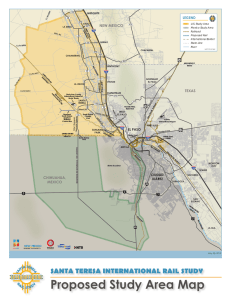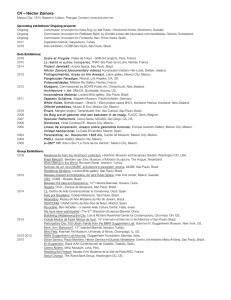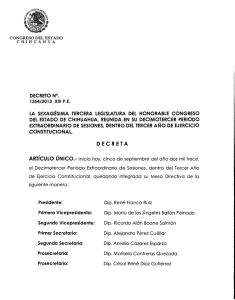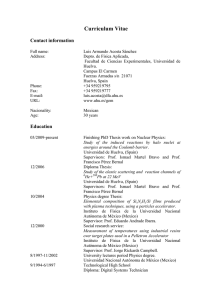New records of Mexican Tardigrada
Anuncio
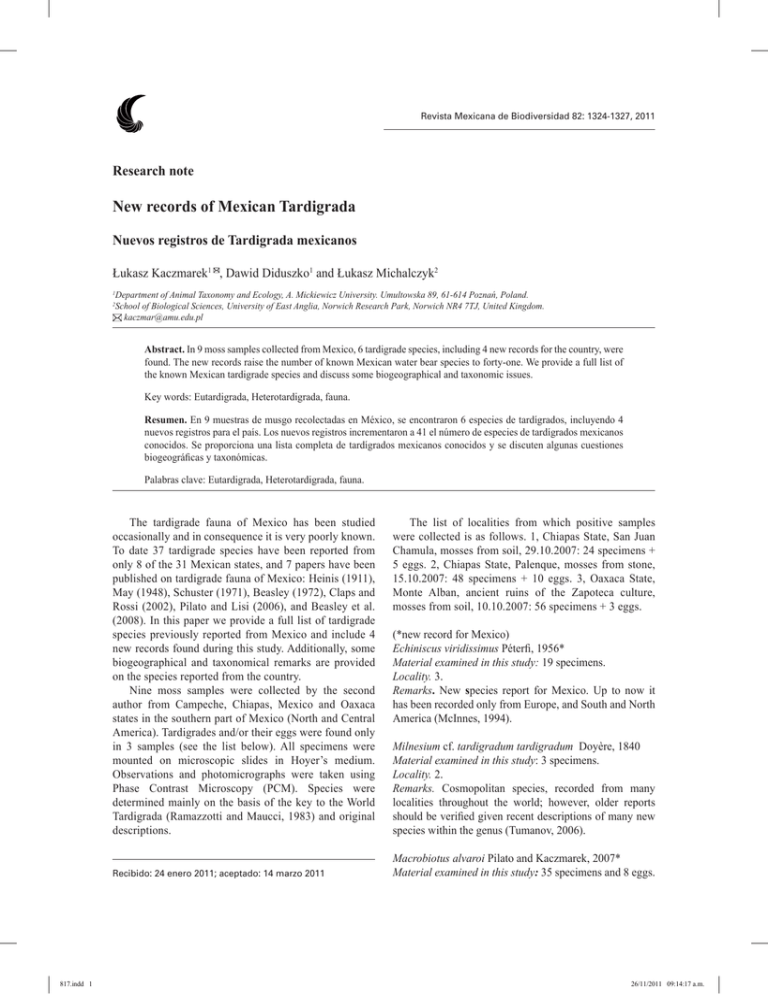
Revista Mexicana de Biodiversidad 82: 1324-1327, 2011 Research note New records of Mexican Tardigrada Nuevos registros de Tardigrada mexicanos Łukasz Kaczmarek1 , Dawid Diduszko1 and Łukasz Michalczyk2 Department of Animal Taxonomy and Ecology, A. Mickiewicz University. Umultowska 89, 61-614 Poznań, Poland. School of Biological Sciences, University of East Anglia, Norwich Research Park, Norwich NR4 7TJ, United Kingdom. [email protected] 1 2 Abstract. In 9 moss samples collected from Mexico, 6 tardigrade species, including 4 new records for the country, were found. The new records raise the number of known Mexican water bear species to forty-one. We provide a full list of the known Mexican tardigrade species and discuss some biogeographical and taxonomic issues. Key words: Eutardigrada, Heterotardigrada, fauna. Resumen. En 9 muestras de musgo recolectadas en México, se encontraron 6 especies de tardígrados, incluyendo 4 nuevos registros para el país. Los nuevos registros incrementaron a 41 el número de especies de tardígrados mexicanos conocidos. Se proporciona una lista completa de tardígrados mexicanos conocidos y se discuten algunas cuestiones biogeográficas y taxonómicas. Palabras clave: Eutardigrada, Heterotardigrada, fauna. The tardigrade fauna of Mexico has been studied occasionally and in consequence it is very poorly known. To date 37 tardigrade species have been reported from only 8 of the 31 Mexican states, and 7 papers have been published on tardigrade fauna of Mexico: Heinis (1911), May (1948), Schuster (1971), Beasley (1972), Claps and Rossi (2002), Pilato and Lisi (2006), and Beasley et al. (2008). In this paper we provide a full list of tardigrade species previously reported from Mexico and include 4 new records found during this study. Additionally, some biogeographical and taxonomical remarks are provided on the species reported from the country. Nine moss samples were collected by the second author from Campeche, Chiapas, Mexico and Oaxaca states in the southern part of Mexico (North and Central America). Tardigrades and/or their eggs were found only in 3 samples (see the list below). All specimens were mounted on microscopic slides in Hoyer’s medium. Observations and photomicrographs were taken using Phase Contrast Microscopy (PCM). Species were determined mainly on the basis of the key to the World Tardigrada (Ramazzotti and Maucci, 1983) and original descriptions. Recibido: 24 enero 2011; aceptado: 14 marzo 2011 817.indd 1 The list of localities from which positive samples were collected is as follows. 1, Chiapas State, San Juan Chamula, mosses from soil, 29.10.2007: 24 specimens + 5 eggs. 2, Chiapas State, Palenque, mosses from stone, 15.10.2007: 48 specimens + 10 eggs. 3, Oaxaca State, Monte Alban, ancient ruins of the Zapoteca culture, mosses from soil, 10.10.2007: 56 specimens + 3 eggs. (*new record for Mexico) Echiniscus viridissimus Péterfi, 1956* Material examined in this study: 19 specimens. Locality. 3. Remarks. New species report for Mexico. Up to now it has been recorded only from Europe, and South and North America (McInnes, 1994). Milnesium cf. tardigradum tardigradum Doyère, 1840 Material examined in this study: 3 specimens. Locality. 2. Remarks. Cosmopolitan species, recorded from many localities throughout the world; however, older reports should be verified given recent descriptions of many new species within the genus (Tumanov, 2006). Macrobiotus alvaroi Pilato and Kaczmarek, 2007* Material examined in this study: 35 specimens and 8 eggs. 26/11/2011 09:14:17 a.m. Revista Mexicana de Biodiversidad 82: 1324-1327, 2011 Locality. 2. Remarks. This is the second report of this species and also the first report outside the type locality (Costa Rica) (Pilato and Kaczmarek, 2007). Macrobiotus coronatus de Barros, 1942 Material examined in this study: 37 specimens and 3 eggs. Locality. 3. Remarks. Species recorded from many localities in Europe, Asia, New Zealand, North, Central and South America and Antarctica (McInnes, 1994). According to Pilato et al. (2000), the only confirmed localities are in South America. This is the first confirmed record of this species in Central America. Macrobiotus persimilis Binda and Pilato, 1972* Material examined in this study: 24 specimens and 5 eggs. Locality.1. Remarks. New species for Mexico. Up to now this species was known only from southern Europe, northern Africa, Australia and Greenland (McInnes, 1994). Macrobiotus terminalis Bertolani and Rebecchi, 1993* Material examined in this study: 10 specimens and 2 eggs. Locality.3 Remarks. New species for Mexico. Up to now this species was known only from southern Europe (Bertolani and Rebecchi, 1993). 1325 This paper adds 4 new records to a short list of known Mexican tardigrade species (41 species). All these species were reported from only 8 Mexican states whereas in other 23 states data are lacking (Table 1). Moreover, nearly half (16) of the known species are considered cosmopolitan, which means that these records are doubtful and need to be confirmed. Interestingly, 5 species were reported only once from their type localities. The remaining species are known from a range of biogeographical regions: Neotropical (10 species), Nearctic (6), Palearctic (6), Holarctic (3), Afrotropical and Australian (1). A large proportion of Neotropical species suggests a major influence of this region on the tardigrade fauna of Mexico, and the presence of species from the Palearctic, Nearctic and Neotropical regions indicates that Mexico is situated on the border of 2 large biogeographical regions, the Nearctic and Neotropical. Nevertheless, the low number of known Mexican tardigrade species currently prevents any biogeographical analysis. We are grateful to Alvaro Herrera (INBio, Costa Rica) for his translation of the title and abstract of this manuscript to Spanish. The research was partially supported by The Polish Ministry of Science and Higher Education via the programme “Iuventus plus”, grant no. IP2010 015570 to ŁK Table 1. A list of all known Mexican tardigrade species with their localities (states) and biogeographic and taxonomic comments Species Cornechiniscus lobatus (Ramazzotti, 1943) Diphascon (Diphascon) chilenense Plate, 1888** D. (D.) nodulosum (Ramazzotti, 1957) Doryphoribius evelinae (Marcus, 1928) D. flavus (Iharos, 1966) D. gibber Beasley and Pilato, 1987 D. mexicanus Beasley, Kaczmarek and Michalczyk, 2008 Echiniscus kerguelensis Richters, 1904 E. kofordi Schuster and Grigarick, 1966 E. siegristi Heinis, 1911 E. tamus Mehlen, 1969 E. viridis Murray, 1910 E. viridissimus Péterfi, 1956 Haplomacrobiotus hermosillensis May, 1948 Hypsibius convergens (Urbanowicz, 1925)** 817.indd 2 States Source Sinaloa Chihuahua Mexico Chihuahua 4 3 4 3 Chiapas Chiapas Oaxaca 6 6 7 Mexico and Morelos Chiapas Oaxaca Chihuahua Chihuahua 4 6 1 3 3 Oaxaca 8 Sonora Chihuahua 2 3 Remarks Recorded from the Holarctic realm Cosmopolitan Recorded from the Nearctic region and New Zealand Recorded from the Holarctic realm and the Neotropical region Recorded from the Palearctic and Neotropical regions Nearctic species Recorded only from the type locality Cosmopolitan species (excluding South America and Asia) Recorded from the Neotropical and Nearctic regions Recorded only from the type locality Nearctic species Recorded from the Holarctic realm and the Neotropical region (Pilato et al. 2007 and 2008) Recorded from the Holarctic realm and the Neotropical region (Pilato et al. 2007 and 2008) Nearctic species Cosmopolitan 26/11/2011 09:14:17 a.m. 1326 Kaczmarek et al.- Mexican Tardigrada Table 1. Continues Species H. pallidus Thulin, 1911** Isohypsibius sattleri (Richters, 1902) I. sculptus (Ramazzotti, 1962) Itaquascon umbellinae de Barros, 1939 Macrobiotus alvaroi Pilato and Kaczmarek, 2007 M. ascensionis Richters, 1908 M. contii Pilato and Lisi, 2006 M. coronatus de Barros, 1942 M. echinogenitus Richters, 1904** M. h. harmsworthi Murray, 1907** M. h. hufelandi C.A.S. Schultze, 1833** M. persimilis Binda and Pilato, 1972 M. rubens Murray, 1907 M. terminalis Bertolani and Rebecchi, 1993 Milnesium t. tardigradum Doyère, 1840** Minibiotus continuus Pilato and Lisi, 2006 M. furcatus (Ehrenberg, 1859) M. intermedius (Plate, 1888)** Paramacrobiotus areolatus (Murray, 1907)** P. richtersi (Murray, 1911)** Pseudechiniscus facettalis Petersen, 1951 P. gullii Pilato and Lisi, 2006 P. juanitae de Barros, 1939 P. suillus (Ehrenberg, 1853) Ramazzottius baumanni (Ramazzotti, 1962) Ramazzottius oberhaeuseri (Doyère, 1840)** States Source ? Chiapas Morelos Chihuahua 5 6 4 3 Chiapas ? Chiapas Chihuahua and Oaxaca Mexico Sinaloa and Oaxaca Chihuahua, Mexico, and Oaxaca Chiapas Oaxaca Chiapas Chihuahua, Mexico, Morelos Chiapas Mexico and Morelos Chihuahua Chihuahua Chihuahua Chihuahua Chiapas Chiapas Oaxaca Mexico, Michoacán, Morelos Mexico and Michoacán Remarks Cosmopolitan Cosmopolitan Recorded from the Palearctic and Neotropical regions Recorded from the Palearctic and Neotropical regions, and New Zealand 8 This is the only record apart from the type locality in Costa Rica 5 Recorded from Caucasus 6 Recorded only from the type locality 3, 8 Cosmopolitan 4 Cosmopolitan. A doubtful record based on a single specimen (without eggs) 1, 4 Cosmopolitan 1, 3, 4 Cosmopolitan 8 1 Palearctic species, but also known from Australia Recorded from the Neotropical, Afrotropical, Australian and Palearctic regions 8 Up to now recorded only from the Palearctic region 3, 4, 8 Cosmopolitan 6 4 3 3 3 3 6 6 1 4 4 Recorded only from the type locality Cosmopolitan Cosmopolitan Cosmopolitan Cosmopolitan Cosmopolitan species (excluding Asia) Recorded only from the type locality Recorded from the Palearctic and Neotropical regions Cosmopolitan Recorded from the Nearctic and Neotropical regions, and New Zealand Cosmopolitan 1, Heinis (1911); 2, May (1948); 3, Schuster (1971); 4, Beasley (1972); 5, Ramazzotti and Maucci (1983); 6, Pilato and Lisi (2006); 7, Beasley, Kaczmarek and Michalczyk (2008), 8, current study. **Doubtful species, now considered as groups of very similar taxa (i.e. all older reports should be confirmed). Literature cited Beasley, C. W. 1972. Some tardigrades from Mexico. Southwestern Naturalist 17:21-29. Beasley, C. W., Ł. Kaczmarek and Ł. Michalczyk. 2008. Doryphoribius mexicanus, a new species of Tardigrada (Eutardigrada, Hypsibiidae) from Mexico (North America). Proceedings of the Biological Society of Washington 121:34-40. Bertolani, R. and L. Rebecchi. 1993. A revision of the Macrobiotus hufelandi group (Tardigrada, Macrobiotidae), with some observations on the taxonomic characters of eutardigrades. Zoologica Scripta 22:127-152. 817.indd 3 Claps, M. C. and G. Rossi. 2002. Tardigrada: 171-186. In Biodiversidad, taxonomía y biogeografía de artrópodos de México: hacia una síntesis de su conocimiento, vol. III, J. Llorente-Bousquets and J. J. Morrone (eds.). Universidad Nacional Autónoma de México, México, D.F. p. 171-186. Heinis, F. 1911. Beitrag zur Kenntnis der zentralamericanischen Moosfauna. Revue Suisse de Zoologie 19:253-266. May, R. M. 1948. Nouveau genre et espèce de tardigrade du Mexique: Haplomacrobiotus hermosillensis. Bulletin de la Société Zoologique de France 73:95-97. McInnes, S. J. 1994. Zoogeographic distribution of terrestrial/ freshwater tardigrades from current literature. Journal of Natural History 28:257-352. 26/11/2011 09:14:17 a.m. Revista Mexicana de Biodiversidad 82: 1324-1327, 2011 Pilato, G. and Ł. Kaczmarek. 2007. Macrobiotus alvaroi, a new species of eutardigrade (Tardigrada, Macrobiotidae) of the polyopus group from Costa Rica (Central America). Zootaxa 1479:1-7. Pilato, G. and O. Lisi. 2006. Notes on some tardigrades from southern Mexico with description of three new species. Zootaxa 1236:53-68. Pilato, G., M. G. Binda, A. Napolitano and E. Moncada. 2000. The specific value of Macrobiotus coronatus DeBarros 1942, and description of two new species of the harmsworthi group (Eutardigrada). Bollettino delle sedute dell’Accademia Gioenia di Scienze Naturali 33:103-120. Pilato, G., P. Fontoura and O. Lisi. 2007. Remarks on the Echiniscus viridis group, with the description of a new 817.indd 4 1327 species (Tardigrada, Echiniscidae). In Proceedings of the Tenth International Symposium on Tardigrada, G. Pilato and L. Rebecchi (guest editors). Journal of Limnology 66:33-39. Pilato, G., P. Fontoura and O. Lisi. 2008. New description of Echiniscus viridis Murray, 1910 and remarks on the viridis group. New Zealand Journal of Zoology 35:85-92. Ramazzotti, G. and W. Maucci. 1983. Il Phylum Tardigrada. Memorie dell’Instituto Italiano di Idrobiologia 41:1-1012. Schuster, R. O. 1971. Tardigrada from Barranca del Cobre, Sinaloa and Chihuahua, Mexico. Proceedings of the Biological Society of Washington 84:2130-224. Tumanov, D. V. 2006. Five new species of the genus Milnesium (Tardigrada, Eutardigrada, Milnesiidae). Zootaxa 1122:1-23. 26/11/2011 09:14:17 a.m.
